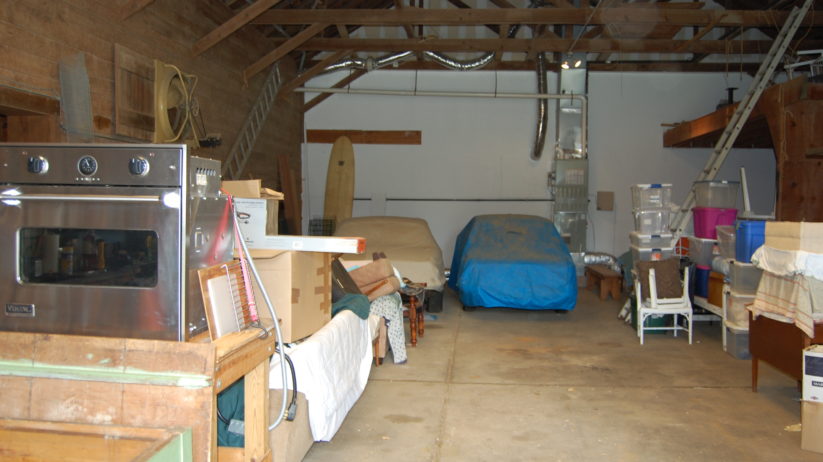Last week I talked about having an inside line on a 48,000-mile original-owner ’73 2002 in Bridgehampton that had been sitting in storage since 2008 and was currently immobilized due to a seized handbrake. I had many verbal and electronic conversations with the owner, a woman named Eileen; she described the car as rust-free and in nearly-new condition. She said that she loved the car, but she now lived in the city, no longer came out to Bridgehampton regularly, and had been paying for storage there for fifteen years; she wanted to find a good home for the car, but still get a fair price for it. I did my best to do my “two hats” thing of advising her while also possibly being interested. I’ve never found this to be a conflict of interest as long as I’m unflinchingly honest about everything.
After seeing pictures of the car, I was intrigued, but explained that it looked more like a driver-quality survivor needing work and clean-up than a mint, in-the-box time capsule that would easily bring big money. I gave her some sets of bracketing values of what I thought the car might fetch on Bring a Trailer in as-is, cleaned-up, running, and fully sorted condition.
We also threw around some hypothetical I-come-down-and-drag-it-away numbers.
Not surprisingly, mine were too low for her, and hers were too high for me. Eventually we made an agreement: I would come down and look at the car. If I didn’t buy it myself—and I felt that the chances were slim that I would, since her number was money I simply didn’t have—then for a flat fee of a thousand dollars plus expenses, I’d represent it for her on BaT. I’d try to un-stick the car’s seized handbrake, verify that the engine wasn’t seized, suss out the condition of the car, photograph it, and take any relevant paperwork with me. Then I’d go back home, write up the auction, submit it to BaT under my account, and answer any questions on her behalf. She’d still need to deal with showing the car to potential buyers and meeting a shipper after the sale herself.
I explicitly said that I would not take the car back to Boston and broker the whole thing for her, as I didn’t have the space for it and didn’t want the liability. She asked me about coming down with a battery and a gas can and seeing if the car could be started and driven. I explained why more care than that should go into a start of a long-dormant car, and added that if I wanted to buy it myself, I wouldn’t try to get it running—I’d rather take the risk and buy it dead to keep the price down—but if I was passing on the car, then, time permitting, if she wanted, I could try to revive it.
As the date neared, my finances improved a bit, and I decided that the drive was long enough that I might as well bring a truck and a trailer to enable the possibility of buying the car and dragging it back, so I borrowed a truck and reserved a U-Haul trailer. The day before I left, the reservation for the U-Haul fell through, so I scrambled and borrowed a big flatbed trailer from my friend Wink Cleary. It took the better part of two days and 140 miles to get the borrowed truck and trailer in my driveway, but the pieces were finally lined up.
On Saturday, September 14, at 5:15 a.m., I left West Newton. The early departure worked like a charm; I hit perhaps five minutes of traffic where the Throgg’s Neck Bridge meets the Long Island Expressway. At 10:45 a.m., I found myself on a manicured tree-lined street in the tony environs of Bridgehampton. Oh, I thought; it’s one of those neighborhoods. It reminded me of ‘Sconset on Nantucket. There was no mistaking that I’d driven into money.
I found the street number on a mailbox at the top of a long, narrow driveway whose end I could not see. When towing a trailer, I’m hesitant to go down a road that might be a dead end, so I waited on the street. After a few minutes, Eileen arrived, and I followed her to the end of the driveway. On the right, there was a near-mansion-size house with a turn-around circle in front of it. On the left was a more modest house with an attached barn. Eileen said that she’d been renting storage for the 2002 and her ’73 Jaguar XJ6 in the attached barn for about fifteen years.
I looked at the geometry. In front of the barn was a patch of lawn, and next to that was a short section of driveway that was at a dogleg angle relative to the main driveway. This was not the easy-to-back-the-trailer-up-to-the-door scenario I’d imagined. No one appeared to be home at the mansion-sized house on the right, so I swung the truck and the trailer around the circle and pointed the rig up the main driveway.
Just then, Eileen’s friend from whom she rented the space in the barn, an affable man named King, came out. He said that I could back the truck and trailer onto the lawn in front of the barn door, if that’s what needed to be done. I appreciated that, but due to the dogleg turn and a utility pole and a supporting guy wire in the way, this was not trivial; I wondered if it would be easier to back a passenger car into the barn and drag the 2002 out with a tow strap. I commented that a shipper hired by a BaT buyer would likely have trouble, that they’d probably ask that the car be brought out onto the street.
But I hadn’t even seen the 2002 yet, and it had seized rear brakes; talking about loading it was putting the cart way before the horse.
After multiple attempts, I successfully backed the trailer into King’s gravel driveway just to get it out of the way in case Homeowner #2 came home. I went inside the barn. Eileen’s two decade-dormant cars were at the far end.
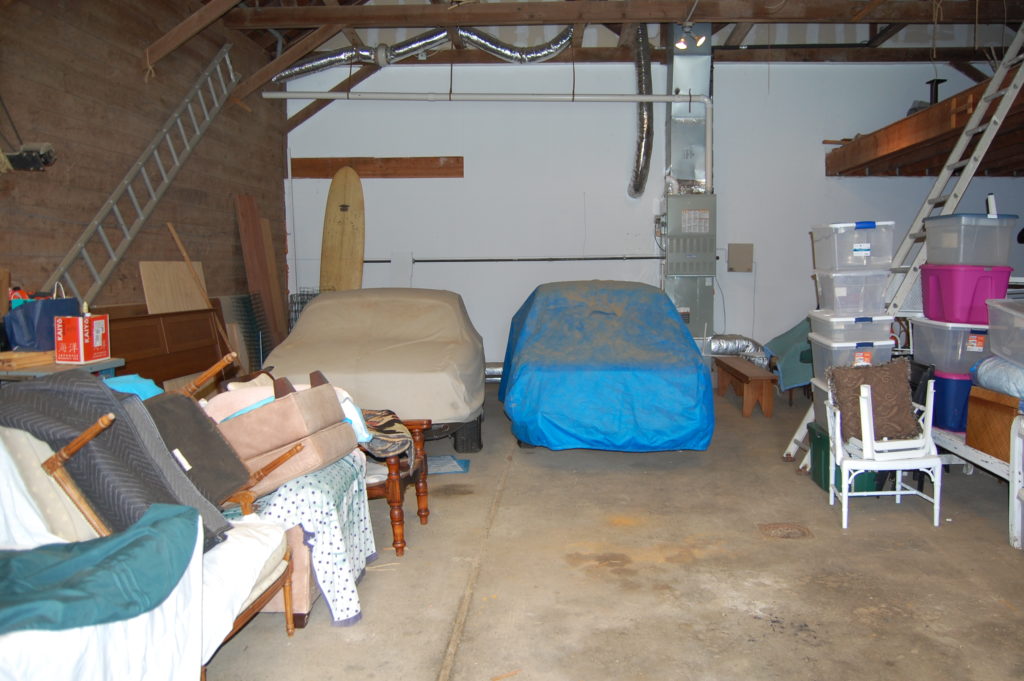
The 2002 is the one under the blue cover, and the XJ6 is on the left.
Few things are as portentous as a barn-find unveiling. I uncovered the 2002 and walked around it to get the scent on me. The Chamonix (white) paint was shiny, but I was strangely unimpressed. “What do you think?” Eileen asked.
“I’m not feeling the lust,” I said. She was surprised. Even I was surprised.
I explained that my ’72 2002tii had the same Chamonix/Navy color combination, so I already own a car that looked just like this one, and the kind of money we were talking about buys a lot of interesting cars. Lack of lust, though, is useful, in that it keeps one firmly ground and not doing the Frye/Futurama “SHUT UP AND TAKE MY MONEY” thing.
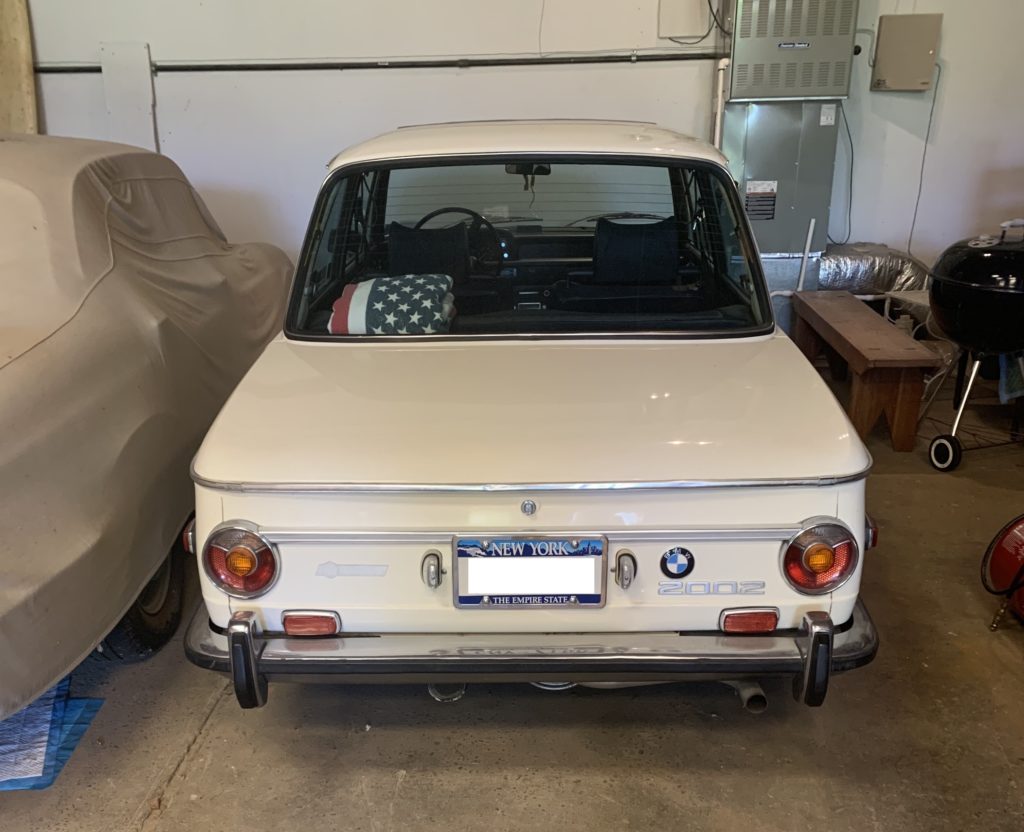
The reveal.
But when I opened the car’s door, I swung around a bit to Eileen’s point of view. The interior was gorgeous: rip-free seats, uncut door panels, original radio, completely intact door chrome, lovely original rugs, very good headliner, one small dash crack. It completely jibed with the story of it being a 48,000-mile car.
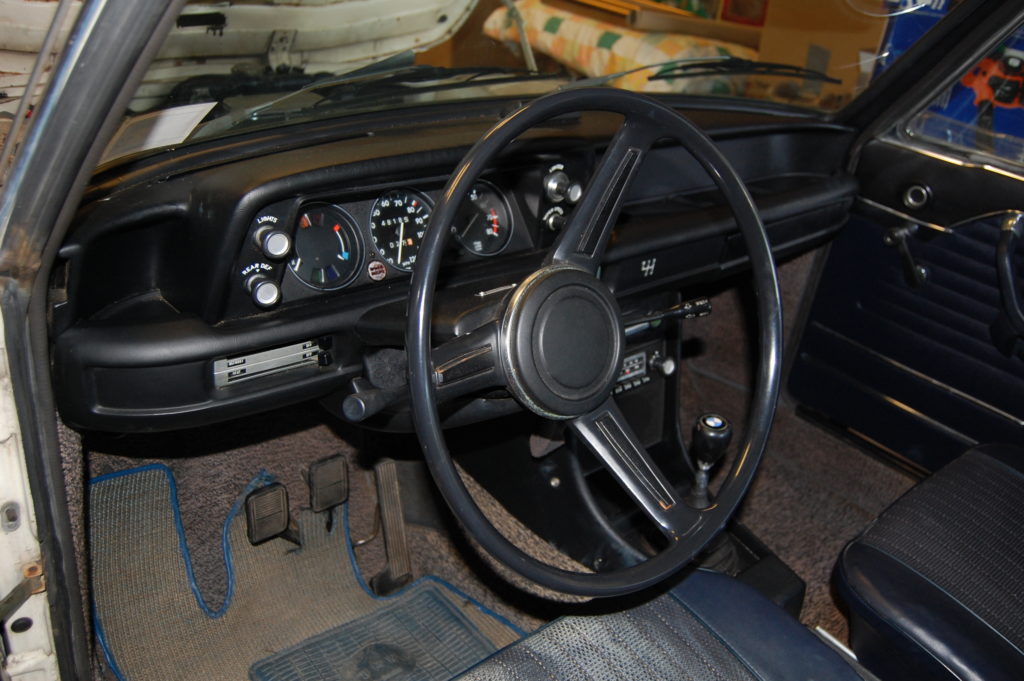
Delicious, right?
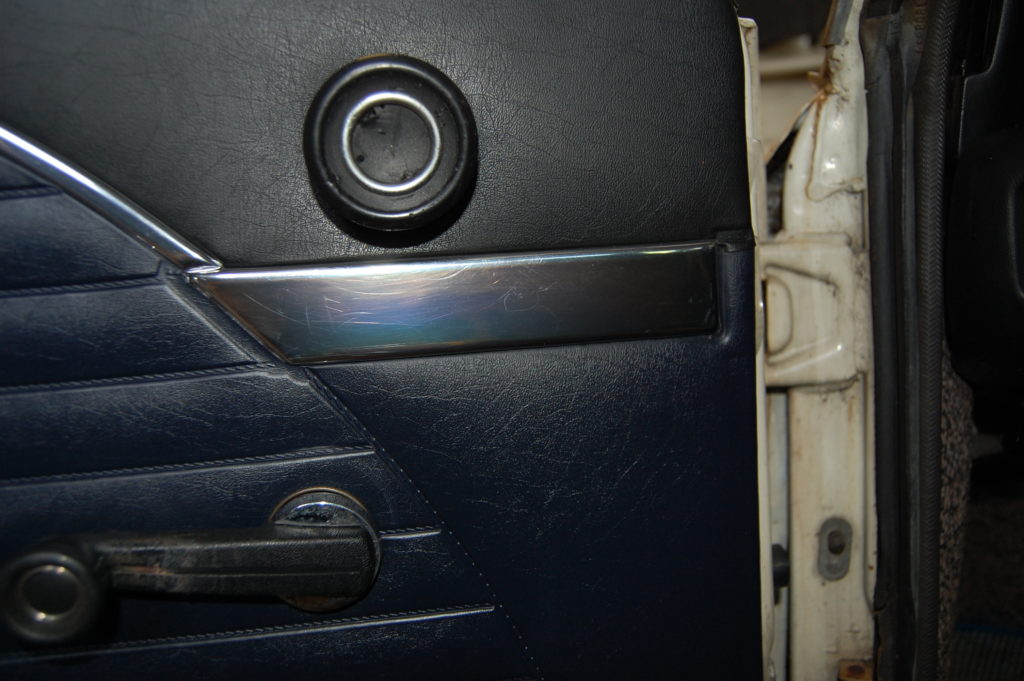
I’m not sure I’ve ever seen completely intact chrome on the door trim before.
I then checked the engine by putting the car in neutral, grabbing the fan blades with one hand, leaning on the fan belt with the heel of my other hand, and rotating the blades. The engine wasn’t seized; however, a fair amount of antifreeze immediately began dripping from under the nose of the car. I looked underneath and saw that there was an existing puddle; clearly it had been slowly leaking for a while.
I opened up the radiator and found that the top tank was completely empty. Although I couldn’t localize the source of the leak, since it appeared to have started when I rotated the engine, it was likely coming from the water-pump seal. I moved the fan blades fore and aft. There was a little play, but nothing that screamed of a failed bearing.
Next, I went to un-stick the handbrake. The 2002 was parked very close to Jaguar, so I used the small floor jack I’d brought to jack up the back of the car and slide it sideways to make room. I then pulled both wheels off and smacked the flat part of the drums with a small sledgehammer. Both rear brakes quickly submitted to the onslaught. I’d just added value to the car—anyone, not just me, could now roll it out—but this was part of my agreement with Eileen.

The Hack does the jack-and-smack.
Then it was on to the main event: examining the body closely. Eileen had called the car “rust-free,” but there’s no way to know until you jack it up and crawl under. The good news was that the car was as rust-free as survivor 2002s come. There was one dime-sized rust blister on the left door (visible in the photo above), and some non-trivial corrosion at the bottoms of both doors, but I did not find a rust hole anywhere on the car.
The not-so-good news was that there were a fair number of blemishes on the body that were less than blatant dents but more than just door dings, including an above-bumper tap of the rear clip that pushed it in very slightly at one point. There was also a bad corrosion blemish on the left ear of the front bumper. The more I looked, the more of these things I found.
Then I opened the hood.
In the photos, the engine compartment had looked like a mess. In person, it looked even worse. Most alarming was the black stuff I saw on the nose behind headlight buckets; the more I looked in the engine compartment, the more of it I found. I asked Eileen if the car had been hit in the nose. She said that, yes, it had been tapped at parking speed, and the grilles had been replaced.
I looked at the nose more closely and could see an un-repaired dent below the grilles that was masked by the bumper. She had no idea when and why the black stuff had been sprayed. I explained the problem: The cars that bring all the money on BaT are those that present themselves as a unified whole, and when you see something like this, the whole story of the car being an unmolested survivor begins to fall apart. I guaranteed Eileen that if the car went up on BaT, we’d get nitpicked over this.
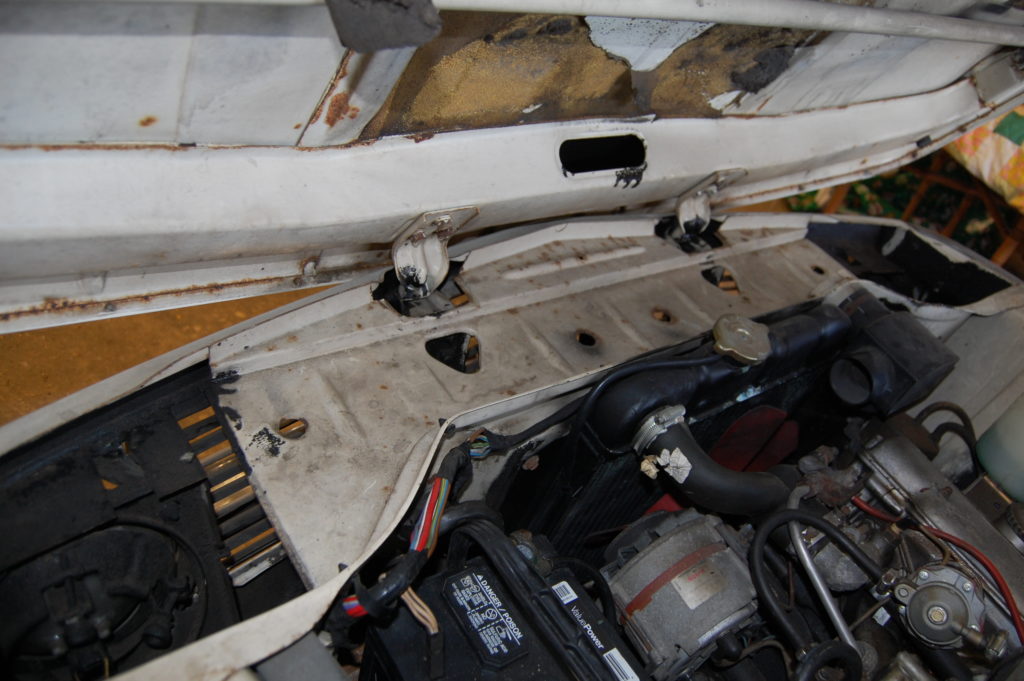
This black stuff in the nose was not original, and thus, not good.

Note unrepaired dents from the grille impact.
I poked around under the hood and found that the brake-fluid reservoir was completely empty. The brake pedal, surprisingly, had pressure (or the hydraulics were seized; it was difficult to tell which), but the clutch pedal was flaccid. Brake fluid doesn’t simply evaporate from the reservoir, so I told Eileen that it had likely leaked out somewhere, although I didn’t see any puddles.
I walked around to the back of the car, unscrewed the gas cap, stuck my nose in the filler neck, and instantly smelled the varnishy smell of old gas. I rhetorically declared, “Gas tank needs to be drained, dropped, and cleaned. Clearly this thing isn’t firing up and driving anywhere anytime soon.”
My bluntly assessing—perhaps unintentionally dissing—Eileen’s original-owner baby in this way was too much. She looked at me with an expression that was so sad I thought she was going to burst into tears. “Is there anything good you can tell me?” she asked.
I thought for a moment, ran out to my truck for tools, pulled the top off the Weber, and was delighted to find a float bowl free of gum or sediment.
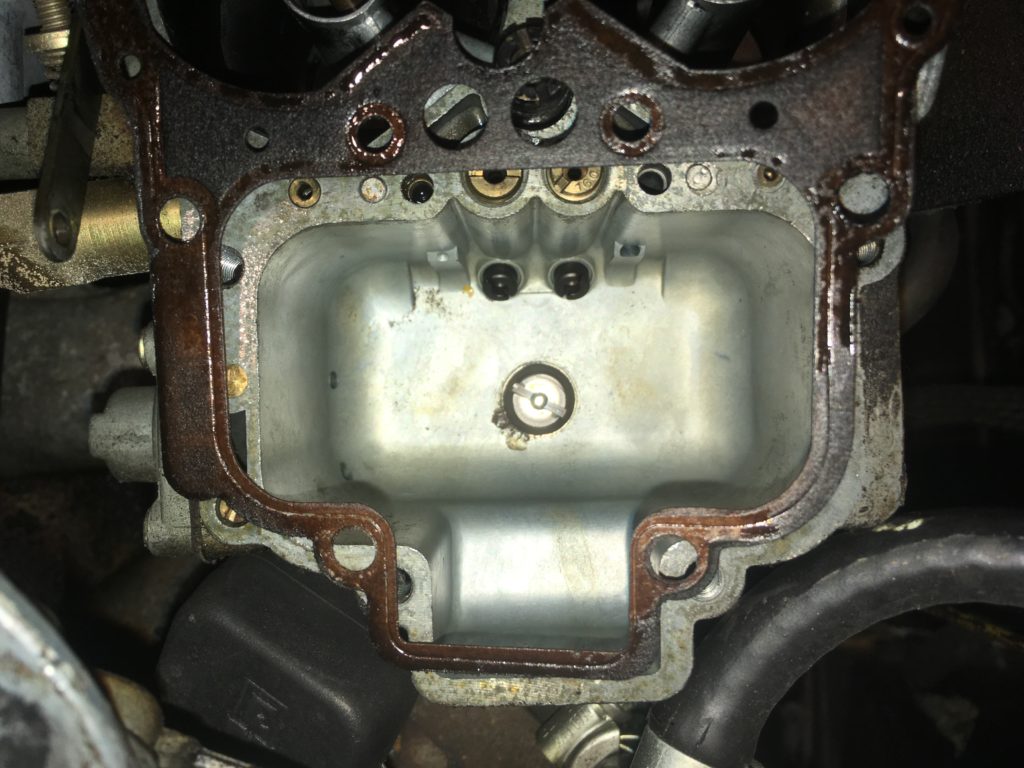
THAT’s what you want to see in a float bowl: nothing.
I thought, “Sheesh, if the clutch hydraulics worked, this thing might move under its own power.” Unfortunately, with everything I’d brought, brake fluid had somehow slipped through the cracks. (As it will…)
I looked on my phone and found a NAPA Auto Parts a quarter of a mile away that closed at 4:00 p.m. Unfortunately, it was 3:55. Eileen and I hopped in her car and dashed there, making it as they were closing the door, and bought brake fluid. We hurried back, and I filled the reservoir and pumped the brake and clutch pedals. I didn’t see fluid streaming out anywhere.
Unfortunately, the clutch pedal didn’t pump up, and I hadn’t brought my proper bleeding equipment. But hey—am I not the Hack Mechanic!? I grabbed a cardboard box, lined it with paper towels, and had Eileen do the down-up thing on the pedal while I opened and closed the bleed valve, bleeding the clutch slave cylinder into the box. I then verified visually that the slave cylinder moved when Eileen hit the clutch pedal, got in the car, started it, put it in gear, and successfully moved it one foot backward and one foot forward.
Wow.
I don’t recall whether I said, “My interest in your car just spiked because now I can probably drive it out, across the lawn, and onto my trailer instead of needing a winch and straps,” but it certainly was what I was thinking.
This kicked off what was literally a three-hour negotiation.
I opened with something like, “First, let’s both agree that I just dramatically increased the value of your car by un-seizing the brakes and getting it running and capable of moving under its own power.”
Then I said something I would regret.
I said that among the conversations we could have were:
- me buying the car outright and towing it away
- following through with our agreement of the car staying here and my representing it for her on BaT for a fee
- profit-sharing with me owning the car, or
- profit-sharing with her owning the car.
I never should’ve mentioned the idea of profit-sharing without having thought it through. It was a big mistake on my part. I was just spitballing after a long day.
We addressed the outright sale part first. “Before I saw the car,” I said, “I offered you X, and you countered with Y. I’ll meet you halfway, and tow it off tonight. What do you think?”
She then made her mistake and countered with a slight increase. I immediately said, “I’m not going to lose a car over five hundred bucks, so yes.” It was more than I wanted to pay—more than I’d ever paid for a 2002; in fact, more than I’d paid for any BMW except the M coupe—but likely less than BaT money, so it seemed like a good compromise. I thought we were done.
And then it went sideways. Eileen walked back her offer, latched onto my ill-thought-out mention of profit-sharing, and wouldn’t let go.
I hadn’t explicitly said that “profit-sharing” included me towing the car off and handling all aspects of the sale, but that’s what was inferred. Why wouldn’t she jump at it? A long impasse followed, during which I advised her multiple times that if she wanted to maximize her profit, all she needed to do was take me up on my original offer to represent the car for her on BaT. She said that it wasn’t so much about the money, it was more that she’d feel like a sap if she saw me put the car on BaT next month and get twice what she sold it to me for, and added that letting it go cheaply felt disrespectful to the car.
I assured her that what I was offering her for the car—scratch that; what she’d offered it to me for and I’d accepted—was a very fair price.
I called Paul Wegweiser, knowing that he’d be fair enough to throw me under the bus if he thought I was full of crap. With Eileen next to me and Paul on speaker, I thoroughly described the car. Paul estimated what he’d pay for it in that condition. The number Eileen and I had agreed on was his upper limit. She largely shrugged this off, saying, “You guys both admit that you’re bottom-feeders.” (This is true.)
King, who came and went several times during the negotiation just to check on us (we were, after all, in his barn), asked about the BaT timeframe. Eileen looked it up on her phone: about a week. We talked: maybe a few days for me to prepare the auction, a week for BaT to post it, a week for it to run, at least a week for payment and shipping. Realistically, it could be a month—or perhaps even two.
King didn’t pressure her, but he played the foil, saying, “Instead of paying me another $150 rent, you could be done with one of these two cars right now.” Eileen had previously said that the fact that she’d paid nearly thirty grand in storage factored into her wanting to get back as much as she could. I did the math in my head; if she’d rented the space for fifteen years (five years active, ten years dead), that’d be just about thirty grand.
And then I heard myself say the phrase “for me to prepare the auction.” Crap—I hadn’t photographed the car yet! I wanted to be able to fulfill our original deal, if that’s what Eileen wanted. We put aside the negotiation, and while there was still ambient light through the barn door, I frantically snapped photos outside, inside, and under the car.
But in photographing the car and pointing to each small body blemish, I was made palpably aware of how many of them there were.

It was a pretty car, but far from mint.
We returned to the negotiation, and both of us hardened our positions. She said, “Would you crow about it online, what you paid?”
I said no, this was a good fair price, by no means thievery.
“Would you keep and treasure the car, or flip it?”
I told her that couldn’t promise to keep it forever, but I did promise that if I sold it, it wouldn’t be before spring, as it needed a lot of work to maximize its value.
“I’m sure,” she said, “that the work will be easy. It’s always been a great car. Everything that you said would be hard today in the garage—un-seizing the brakes, starting it, getting the clutch to work—was easy.”
I said that there was absolutely no way to know this. I added that the car being great for her wasn’t really germane, the fact that it appeared “easy” for me to un-seize the brakes and get the car running and moving was a product of 35 years of experience, and that she could reap the benefits of that experience by simply taking me up on my original offer to leave the car here and rep it for her on BaT.
To have me take the car back to Newton while she still owned it, sort it out, and handle the entire sale for her, was never something that I’d offered, as it seemed fraught with liability for me. To have me buy and own the car, take on all the risk, do all the work, and share the profit with her wasn’t something I was willing to do, even though in a careless moment I’d thrown it against the wall as a possibility.
By this time it was 7:00 p.m. and getting dark. I made a decision.
I said that we could both hold our heads high, that we’d done good work and negotiated respectfully, that I knew that I was leaving the car in much better condition than I’d found it, and that my advice was that she not sell it to me, and instead simply leave the car here and have me list it on BaT for her. I was ready to drive off into the night (or at least as far as my son’s father-in-law’s sister’s house in Southampton). It wasn’t a negotiating tactic; I was done.
Eileen said, “You know what? Let’s just do it.”
At that moment, King walked back in. “Are you two still at it?” he laughed.
“We just agreed that I’m buying it,” I said.
“Have you shaken on it?” he asked.
I did something I never do: I extended the Wheeler-Dealers Mike Brewer big outstretched arm to gently force closure. We shook. I wrote a check. Done.
Finally.
I asked “Does the car have a name?”
Eileen nodded. “Baby.”
“BABY?” I said. “I can’t call it Baby. My car guy friends would be merciless.”
She said, “How about Bay-Bay?” We laughed and took a selfie of us both in front of the car.
And then, over the next ten minutes, the whole thing partially unraveled again. I looked at her title and saw the original dealer service book that backed up the low mileage claim, but Eileen didn’t want to sign over the title to me until my check cleared, which wasn’t unreasonable. Then she said that she wanted to think about it overnight. I said that was fine, and that I’d still remotely rep the car for her on BaT if that’s what she wanted. I gave her till 8:00 a.m. to rip up the check.
In the morning, Eileen called and said. “I guess you bought the car.” I asked if she was okay with that, and she said no, but that it had taken her three hours to drive back to the city last night, and she didn’t have the energy to keep running back and forth to deal with the car.
So, I bought the car for a very fair “I showed up, did all the work, and made it go away” price, but it was not a satisfying ending for either of us. The seller had contacted me for help. I gave her hours of free advice, drove round-trip from Boston to Bridgehampton, got her car unstuck, got it running and potentially mobile, and right to the end, was willing to fulfill our carefully-engineered agreement of a straight fee for leaving the car where it sat and representing it for her on BaT. But because I’d carelessly mentioned the phrase “profit-sharing” only to walk it back, the effort ended with the false though nagging specter that I’d done something wrong and leveraged the situation to my advantage.
In the future, I’m going to need to think more carefully about my long-held “two hats” position.—Rob Siegel
(Next week: The drag back home, and—what did I just buy?!)
(Postscript: The title-swapping aftermath went without a hitch. Eileen and I are on good terms.)
_________________________________
Rob’s new book, Resurrecting Bertha: Buying Back Our Wedding Car After 26 Years In Storage, was just released and is available on Amazon here. His other books, including his recent Just Needs a Recharge: The Hack MechanicTM Guide to Vintage Air Conditioning, are available here on Amazon. Or you can order personally-inscribed copies of all of his books through Rob’s website: www.robsiegel.com.

